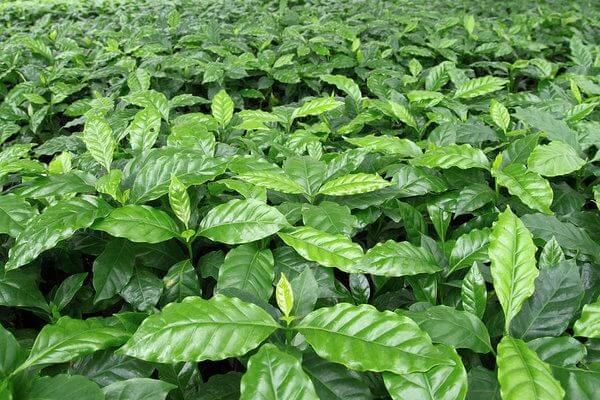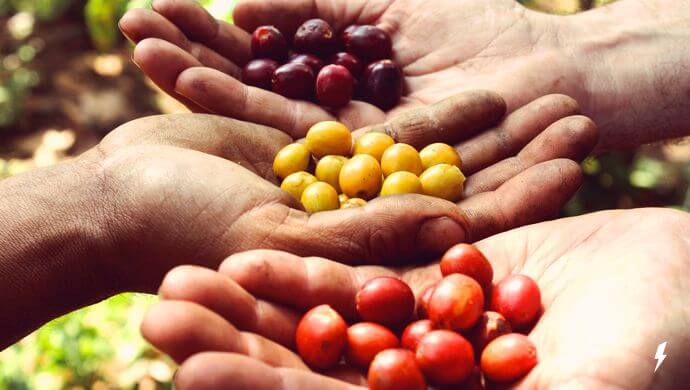What kinds of coffee beans do you have? An introduction to the Origin of Coffee Variety names and the relationship between Coffee varieties
Professional coffee knowledge exchange more coffee bean information please follow the coffee workshop (Wechat official account cafe_style)
This article will analyze the origin of coffee variety names through the history and migration of coffee, and what is the relationship between coffee varieties?
Through the observation and classification of science and plant morphology, we will find that almost all the varieties circulating around the world come from the same ancient tree species, and different tree species have been slowly derived from generation by generation.
Why the last article [what are the coffee trees? Unveil the mystery of coffee! It is estimated that there are at least 2000 to 3000 coffee varieties in Ethiopia, but not every tree species can leave Ethiopia and find a suitable environment to continue to take root and breed the next generation.

According to historical records, from Ethiopia across the Red Sea to Yemen, Dutch traders secretly transplanted coffee trees to Java or brought coffee trees to France as gifts. Finally, because of the colonial era of European powers, coffee trees have traveled across the ocean to India, the Caribbean, America and other suitable areas for cultivation.
At that time, coffee trees were brought to a new environment for planting. When coffee trees arrived at a new environment, the spectral range of plant genes became smaller, and varieties gradually began to evolve due to differences in planting environment.
Ethiopian coffee trees have been transplanted all over the world. Why do only a few dozen coffee species exist commercially?
In fact, not all coffee trees can leave Ethiopia to grow in other environments. Because coffee trees have very strict conditions for planting environment, they refuse to marry without good conditions.
Let's continue to know what kind of coffee the cup in our hand comes from and where it comes from!
Who are the coffee varieties that migrate around the world?
Mother of coffee varieties
The current science and technology collects DNA from plants and classifies similar genes one by one through genetic comparison. However, this kind of variety identification method is too expensive and not timely. It is actually inconvenient for coffee bean buyers and farmers. Therefore, coffee buyers or researchers will first observe the appearance of plants to make a preliminary determination of the variety.
Take the purchase of apples as an example, apples have wine red, green or red with yellow apples, apple surface is smoother, rougher differences, etc., are through the observation of different apple appearance difference to carry out demand purchase.
However, this method of identification is called "plant morphology," and coffee varieties are identified according to the appearance of coffee trees, including the shape and color of leaves and veins, the height, height, size and size of coffee trees, the distance between branches of coffee trees, and the color and appearance of coffee fruits.
So what species are being carried around the world?
Iron Pickup Typica
The coffee species that were first brought from Ethiopia to all parts of the world were found to belong to the Arabica species after sampling analysis, and the iron pickup Typica was the first term used to describe coffee varieties. Typica means ordinary in Latin, which means iron pickup Typica is the most common coffee variety seen around the world.
Later coffee trees planted around the world will undergo natural mutations due to environmental conditions, which will cause changes in the appearance and fruit of the coffee tree itself, and then derive different varieties.
Through plant morphology observation, iron pickup Typica has the following characteristics that can be identified
The bud part is bronze
Leaf tips pointed and elegantly curled
Maragojipe
Maragojipe is a small town in Brazil. Coffee trees in Maragojipe are found to have large trunks, leaves, coffee fruits and seeds on the plains where tin card Typica is planted outside the town. Local farmers planted this coffee seed individually and discovered that it was a mutant of the iron pickup Typica, which was named Maragojipe because it was found in the Maragojipe region.
Because Maragojipe coffee seeds are much larger than the usual ones, which is often referred to as "elephant beans".
On the left is a typical coffee bean size, and on the right is an elephant bean Maragojipe.
The iron pickup Typica planted all over the world has different variety names. The usual naming method will come from the name of the village or town where it was found. Here are a few different iron pickup Typica names.
Other Iron Pickups Typica Name:
Other Iron Pickups Typica Name--Origin or Region of Cultivation
Pluma Hidalgo--Mexican Town Machkar
San Ramon--Iron pickup truck grown in Guatemala
San Bernardo--Iron pickup truck grown in Brazil
Kona--iron pickup truck grown in Hawaii
Bergundal/Garundang--Iron pickup truck grown in Indonesia
Kent/Chichumalgur--Iron pickup truck grown in India
Jamaica Blue Mountain--Iron pickup truck grown in Jamaica
Bourbon
Bourbon is another common breed name, but it is actually a member of the Typica family, which is grown on the present-day island of Reunion (Bourbon) in the Indian Ocean and was once a small French island. Seeds brought from France to Bourbon Island as "mother trees" were planted and combined with other local varieties to produce mutations, or other versions of natural mutation into different varieties.
Whatever happened to this particular plant on Bourbon Island, the mutation produced dramatic changes, not only in plant morphology and character, but also in yield.
Bourbon can be identified by the following characteristics through plant morphology observation
The bud part is bright green (lime color)
Bourbon's high yield, Bourbon species popular cultivation in the 19th century, from Brazil to Guatemala, El Salvador and other Central and South American countries, Bourbon has since become the second largest variety after Ethiopia iron pickup Typica.
Caturra
Cadulla Caturra is a region of Brazil where Bourbon is grown, where Bourbon is combined with others to form a varietal Cadulla Caturra, which is shorter and easier to harvest and has higher yields. Interestingly, what actually makes Kadura Caturra shorter is a mutation in a gene segment that controls branch distance from Bourbon.
Cadulla Caturra is a small plant, easy to harvest, and its yield is higher than Bourbon Bour
Here are the Bourbon names grown around the world:
Other Bourbon names--place or region of cultivation
Tekisic--El Salvador
Pacas--El Salvador
Chocola-Brazil
yellow Bourbon--Brazil
Orange Bourbon-Brazil
French Mission-French Bourbon Island
Timo Hybrid
In 1940, a strange thing happened on Timor Island in Indonesia. In an area where iron card Typica was grown, iron card Typica was found to have "heterosis" with the local Robusta variety.
In biological theory, because the number of chromosomes of the two species is fundamentally different, it is basically impossible to breed to produce the next generation, so how to combine into a new species, in fact, scientists have so far been unable to determine why.
The variety retains both Arabica and Robusta, especially Robusta's high disease and pest resistance. For Indonesia, where leaf embroidery disease was rampant at that time, it really solved many problems! So the world began to grow such varieties.
Although the Timors retain Arabica flavor and have the advantage of Robusta disease resistance, they are still inferior to Arabica flavor in terms of flavor.
Catimor
In order to produce higher yields, farmers looked for a high-yield variety, Kadulla Caturra, to try to cross Timo Hybrid, with satisfactory results. Thus, between 1950 and 1960, Catimor varieties were planted all over the world, but for coffee buyers, coffee was still selected according to the flavor of coffee.
Even if Catimor had higher disease resistance or higher yield, it still retained the Robusta gene, and its flavor performance was still inferior to Arabica, resulting in the decline of coffee quality and flavor at that time.
The following are other Old School hybrid varieties:
Mundo Nuovo means "New World" in Portugal and (Typica x Bourbon) is grown in Brazil.
Catuai,(Mundo Nuovo x Caturra) grown in Brazil.
SL-28 (Taganyika Drought Resistant x Sudan Rimi), interbred in the 1920s by Scott Lab.
Pacamara,(Pacas Bourbon x Maragojipe)
green Revolution
What is the Green Revolution? To put it simply, during the 1950s and 1960s, farmers planted hybrids containing the Robusta Robusta gene for coffee trees with high yield and high disease resistance. Coupled with the fact that coffee drinkers were not particular about the flavor at that time, the quality of coffee began to decline.
As a result, coffee buyers, farmers and scientists gradually realized that coffee flavor is the most important key to tasting coffee, so they began to improve agricultural quality in a scientific way. The above coffee varieties, whether mutants, hybrids or artificial breeding, actually have the same purpose:
Increase the output of coffee
Increase the disease resistance of coffee trees
The convenience of harvesting coffee fruits
Enhance the flavor of coffee
However, the "modern hybrid technology" carried out through the laboratory in recent decades shows that scientists have already begun to improve the quality of agriculture, and another important purpose is to breed coffee varieties with good yield, disease resistance and flavor through scientific methods.
The following is a mix of coffee research institutions and units in various countries:
Colombia-- Columbia Coffee Alliance
Ruiru 11mer-Kenya Coffee Research Institute
The Katim variety developed by Sarchimor-- Costa Rica
Ateng-- Indonesia
Icatu-- Colombia
Castillo-- Colombia
IHCAFE 90-Honduran Coffee Research Institute
Conclusion
Now we finally have a better understanding of the variety of coffee. The next time you go into a cafe and wait for coffee, see if the store sells coffee beans. Remember to pick it up and take a look at the content. There may be the name of the variety shared in this article.
With regard to the Green Revolution, I would like to sincerely thank coffee farmers and scientists for their efforts to ensure that the coffee we have has a good flavor and quality. So every grain of coffee is the hard work of the farmers.
END
Important Notice :
前街咖啡 FrontStreet Coffee has moved to new addredd:
FrontStreet Coffee Address: 315,Donghua East Road,GuangZhou
Tel:020 38364473
- Prev

Arusha Coffee Blue Mountain Arusha Coffee Blue Mountain Arusha varieties in Tanzania
Professional coffee knowledge exchange more coffee bean information Please follow the coffee workshop (Wechat official account cafe_style) anyone who likes coffee knows that coffee in Africa is delicious! The coffee beans bred in this ancient land are more fruity, more acidic, and more fragrant and intoxicating. You know, coffee was first produced in Ethiopia in East Africa. And other African countries
- Next

What kinds of coffee trees are there? Introduction to the origin and characteristics of common coffee varieties
Professional coffee knowledge exchange more coffee bean information please follow the coffee workshop (Wechat official account cafe_style) by understanding the history of coffee [the history and development of coffee! The mysterious red fruit has become a global black gold trend to learn how coffee has spread from Africa to other places. What are the next coffee trees? Uncover the mysterious noodles of coffee
Related
- Detailed explanation of Jadeite planting Land in Panamanian Jadeite Manor introduction to the grading system of Jadeite competitive bidding, Red bid, Green bid and Rose Summer
- Story of Coffee planting in Brenka region of Costa Rica Stonehenge Manor anaerobic heavy honey treatment of flavor mouth
- What's on the barrel of Blue Mountain Coffee beans?
- Can American coffee also pull flowers? How to use hot American style to pull out a good-looking pattern?
- Can you make a cold extract with coffee beans? What is the right proportion for cold-extracted coffee formula?
- Indonesian PWN Gold Mandrine Coffee Origin Features Flavor How to Chong? Mandolin coffee is American.
- A brief introduction to the flavor characteristics of Brazilian yellow bourbon coffee beans
- What is the effect of different water quality on the flavor of cold-extracted coffee? What kind of water is best for brewing coffee?
- Why do you think of Rose Summer whenever you mention Panamanian coffee?
- Introduction to the characteristics of authentic blue mountain coffee bean producing areas? What is the CIB Coffee Authority in Jamaica?

